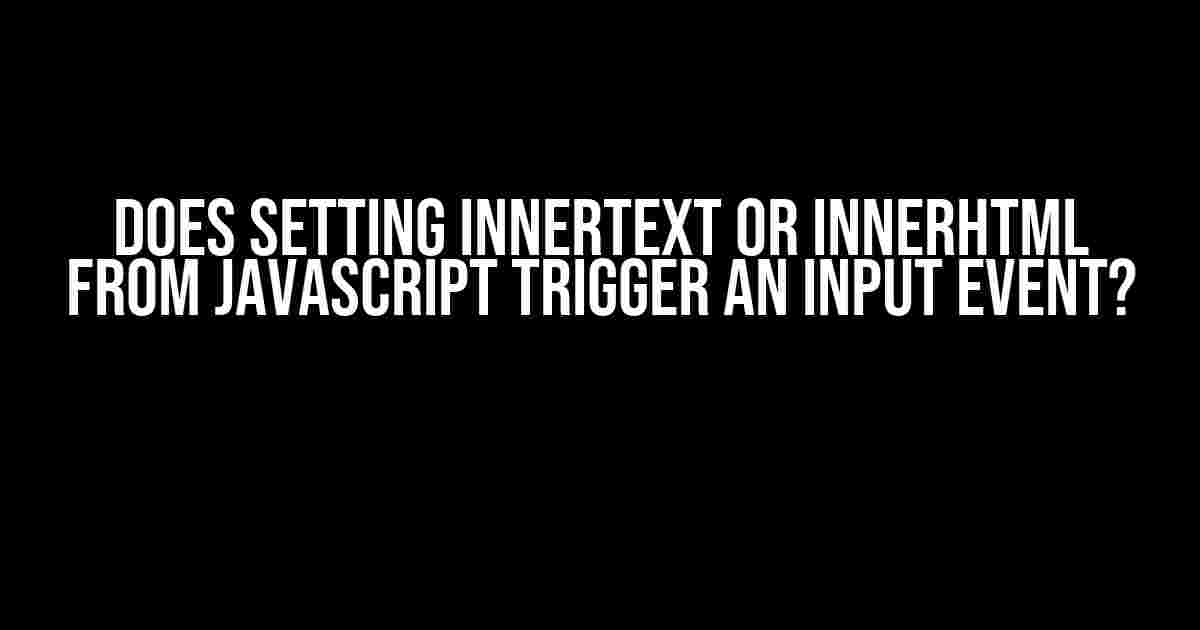As a front-end developer, you’ve probably stumbled upon this question at some point in your coding journey. The answer might seem simple, but trust us, it’s a trap! In this article, we’ll dive deep into the world of JavaScript, HTML, and events to give you a clear understanding of what happens when you set innerText or innerHTML programmatically.
What are innerText and innerHTML?
Before we dive into the juicy stuff, let’s cover the basics. innerText and innerHTML are two properties that allow you to manipulate the content of an HTML element. The main difference between them lies in how they handle HTML tags:
innerText: This property sets or gets the text content of an element, stripping away any HTML tags. It’s like a plain text editor.innerHTML: This property sets or gets the HTML content of an element, preserving any HTML tags. It’s like a rich text editor.
Here’s an example to illustrate the difference:
<div id="myDiv"></div>
const myDiv = document.getElementById("myDiv");
myDiv.innerText = "<b>Hello</b> World!";
// Result: <div>Hello World!</div>
myDiv.innerHTML = "<b>Hello</b> World!";
// Result: <div><b>Hello</b> World!</div>Do innerText and innerHTML Trigger Input Events?
Now that we’ve covered the basics, let’s get to the meat of the matter. When you set innerText or innerHTML programmatically, do they trigger input events?
The Short Answer: No
Programmatically setting innerText or innerHTML does not trigger input events. These events are only fired when the user interacts with the element, such as typing, clicking, or pasting content.
The Long Answer: It Depends
While setting innerText or innerHTML doesn’t trigger input events directly, there are some scenarios where it can have an indirect effect:
- DOM Mutation Events: When you set
innerTextorinnerHTML, the DOM (Document Object Model) is mutated. This can trigger DOM mutation events, such asDOMSubtreeModified,DOMNodeInserted, orDOMCharacterDataModified. These events can be listened to using addEventListener() method. - Input Elements with Default Values: If you set the
valueproperty of an input element (e.g.,<input type="text" />) usinginnerTextorinnerHTML, it will not trigger an input event. However, if the input element has a default value set (e.g.,<input type="text" value="Default Value" />), and you set thevalueproperty programmatically, it can trigger an input event in some browsers (like Chrome). - Accessibility Features: Some screen readers and accessibility tools might interpret programmatically set content as user-generated input, triggering events or announcements. This behavior can vary depending on the tool and the user’s configuration.
Keep in mind that these indirect effects are rare and usually require specific circumstances. In general, setting innerText or innerHTML programmatically will not trigger input events.
Real-World Scenarios and Solutions
Now that we’ve covered the theory, let’s explore some real-world scenarios where you might encounter issues with input events and programmatically set content:
| Scenario | Solution |
|---|---|
| Auto-filling a form input field | Use the value property instead of innerText or innerHTML. This will set the input field’s value without triggering an input event. |
| Updating a live region (ARIA) | Use the aria-live attribute to define the live region, and then update the content using innerHTML or innerText. This will announce the changes to screen readers and other accessibility tools. |
| Implementing a custom input component | Use a combination of addEventListener to capture user input events and programmatically update the component’s value. This will ensure that your custom component behaves like a native input element. |
By understanding how innerText and innerHTML interact with input events, you can create more robust and accessible web applications that cater to a wide range of users and scenarios.
Conclusion
In conclusion, setting innerText or innerHTML from JavaScript does not trigger input events directly. However, there are scenarios where it can have an indirect effect, such as triggering DOM mutation events or affecting accessibility features. By being aware of these subtleties, you can create more effective and user-friendly web applications that meet the needs of your users.
So, the next time you’re working with JavaScript and HTML, remember: setting innerText or innerHTML is not the same as simulating user input. Keep your code clean, efficient, and accessible, and your users will thank you!
Frequently Asked Question
Get the inside scoop on JavaScript and its event triggers – does setting innerText or innerHTML really trigger an input event?
Will setting innerText trigger an input event in JavaScript?
Nope! Setting innerText does not trigger an input event. It simply updates the text content of an element, without firing any events.
What about innerHTML – does it trigger an input event?
No, innerHTML won’t trigger an input event either! While it updates the HTML content of an element, it doesn’t fire any events, including input events.
Are there any scenarios where setting innerText or innerHTML might trigger an event?
Actually, yes! If you have a contenteditable element and you set its innerText or innerHTML, it might trigger an input event. This is because contenteditable elements can fire events when their content changes.
How do I trigger an input event programmatically in JavaScript?
To trigger an input event programmatically, you can use the dispatchEvent method. For example, you can create a new Event object and dispatch it to the target element: `element.dispatchEvent(new Event(‘input’, { bubbles: true }));`.
What’s the takeaway – should I worry about triggering input events when setting innerText or innerHTML?
Relax! In most cases, setting innerText or innerHTML won’t trigger an input event. Just keep in mind the exception for contenteditable elements, and you’re good to go!

